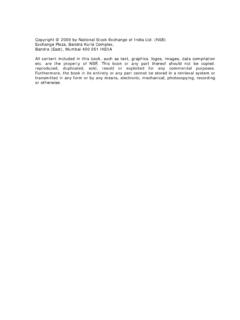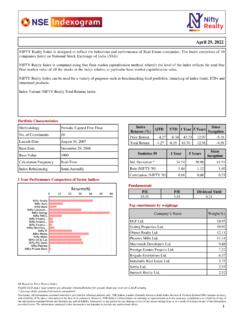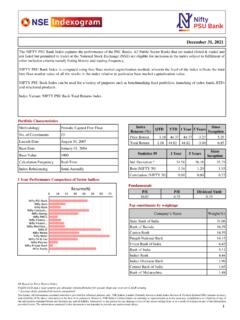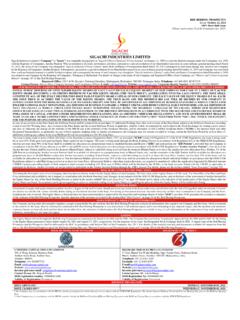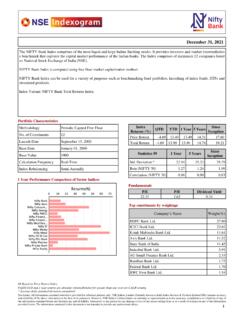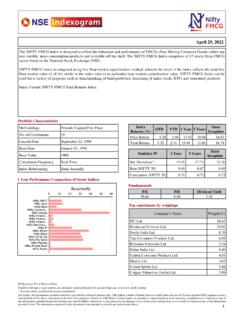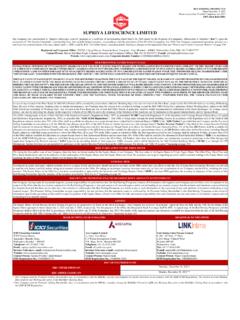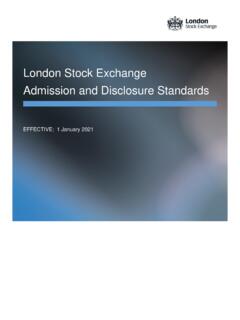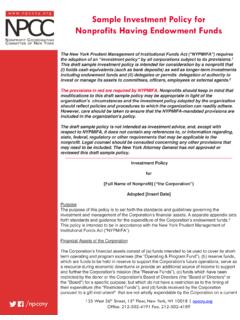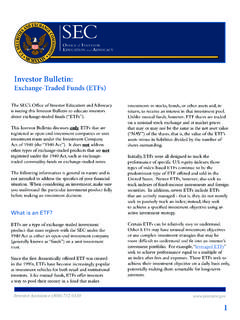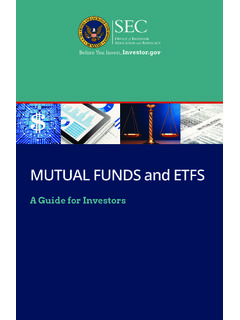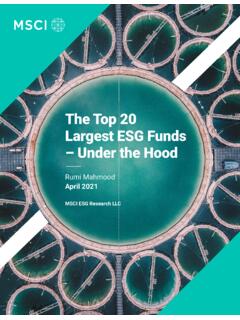Transcription of Index Methodology - National Stock Exchange of India
1 NIFTY 50 Index Methodology October 2019 Contact: Email: Tel: +91 22 26598386 Address: Exchange Plaza, Bandra Kurla Complex, Bandra (East), Mumbai- 400 051( India ) 2 Contents Introduction .. 3 Eligibility Criteria .. 4 Index Construction .. 6 Index Maintenance .. 7 Index Governance .. 9 Index Policy .. 9 Index Calculation formula: .. 11 Index Variants: .. 12 Index Dissemination .. 15 About Us: .. 16 3 Introduction The NIFTY 50 is the flagship Index on the National Stock Exchange of India Ltd. (NSE). The Index tracks the behavior of a portfolio of blue chip companies, the largest and most liquid Indian securities. It includes 50 of the approximately 1600 companies traded (listed & traded and not listed but permitted to trade) on NSE, captures approximately 65% of its float-adjusted market capitalization and is a true reflection of the Indian Stock market.
2 The NIFTY 50 covers major sectors of the Indian economy and offers investment managers exposure to the Indian market in one efficient portfolio. The Index has been trading since April 1996 and is well suited for benchmarking, Index funds and Index -based derivatives. The NIFTY 50 is owned and managed by NSE Indices Limited (formerly known as India Index Services & Products Limited-IISL), India s first specialized company focused on an Index as a core product. Highlights The NIFTY 50 is a 50 Stock , float-adjusted market-capitalization weighted Index for India . It is used for a variety of purposes, such as benchmarking fund portfolios, Index based derivatives and Index funds. The NIFTY 50 is derived from economic research and is created for those interested in investing and trading in Indian equities.
3 Market Representation. The NIFTY 50 stocks represent about 65% of the total float-adjusted market capitalization of the National Stock Exchange (NSE). Liquidity. Market impact cost is the best measure of the liquidity of a Stock . It accurately reflects the costs faced when actually trading an Index . For a Stock to qualify for inclusion in the NIFTY 50, it has to reliably have market impact cost below %, when doing NIFTY 50 trades of Rupees (Rs) 10 crores. Trading in derivative contracts based on NIFTY 50 The National Stock Exchange of India Limited (NSE) commenced trading in derivatives with Index futures on June 12, 2000. The futures contracts on the NSE are based on the NIFTY 50. The Exchange introduced trading on Index options based on the NIFTY 50 on June 4, 2001.
4 Additionally, Exchange traded derivatives contracts linked to NIFTY 50 is traded at Singapore Exchange Ltd. (SGX). 4 Eligibility Criteria Domicile: The company must be domiciled in India and traded (listed & traded and not listed but permitted to trade) at the National Stock Exchange (NSE). Eligible Securities: Constituents of NIFTY 100 Index that are available for trading in NSE s Futures & Options segment are eligible for inclusion in the NIFTY 50 Index . Differential Voting Rights: Equity securities with Differential Voting Rights (DVR) are eligible for inclusion in the Index subject to fulfilment of criteria given below: Market capitalisation criteria is measured at a company level by aggregating the market capitalisation of individual class of security meeting the liquidity criteria for the respective Index Free float of DVR equity class share should be at least 10% of free-float market capitalization of the company (voting equity class share and DVR equity class share) and 100% free-float market capitalization of last security in respective Index It should meet liquidity criteria applicable for the respective Index Upon inclusion of DVRs in Index , the Index may not have fixed number of securities.
5 For example, if DVR of an existing NIFTY 50 constituent is included in NIFTY 50, the NIFTY Index will have 51 securities but continue to have 50 companies It is possible that the DVR is eligible for inclusion in the Index whereas the full voting rights security class is ineligible. In such scenario, the DVRs shall be included in the Index irrespective of whether full voting rights share class is part of Index Selection of the Index set is based on the following criteria: Liquidity: For inclusion in the Index , the security should have traded at an average impact cost of % or less during the last six months for 90% of the observations for a portfolio of Rs. 10 crores. Impact cost is the cost of executing a transaction in a security in proportion to its Index weight, measured by market capitalization at any point in time.
6 This is the percentage mark-up suffered while buying/selling the desired quantity of a security compared to its ideal price -- (best buy + best sell)/2. Float-Adjusted Market Capitalization: Companies will be eligible for inclusion in NIFTY 50 Index provided the average free-float market capitalisation is at least times the average free-float market capitalization of the smallest constituent in the Index . Listing History: A company which comes out with an IPO is eligible for inclusion in the Index if it fulfills the normal eligibility criteria for the Index - impact cost, float-adjusted market capitalization for a three-month period instead of a six-month period. 5 At the time of Index reconstitution, a company which has undergone a scheme of arrangement for corporate event such as spin-off, capital restructuring etc.
7 Would be considered eligible for inclusion in the Index if as on the cut-off date for sourcing data of preceding six months for Index reconstitution, a company has completed three calendar months of trading period after the Stock has traded on ex. basis subject to fulfilment of all eligibility criteria for inclusion in the Index . Trading Frequency: The company s trading frequency should be 100% in the last six months. Index Reconstitution: The Index is reconstituted semi-annually considering 6 months data ending January and July respectively. The replacement of stocks in NIFTY 50 (if any) is generally implemented from the first working day after F&O expiry of March and September. In case of any replacement in the Index , a four weeks prior notice is given to the market participants.
8 Additional Index reconstitution may be undertaken in case any of the Index constituent undergoes a scheme of arrangement for corporate events such as merger, spin-off, compulsory delisting or suspension etc. The equity shareholders approval to a scheme of arrangement is considered as a trigger to initiate the exclusion of such Stock from the Index through additional Index reconstitution. Further, on a quarterly basis indices will be screened for compliance with the portfolio concentration norms for ETFs/ Index Funds announced by SEBI on January 10, 2019. In case of non-compliance, suitable corrective measures will be taken to ensure compliance with the norms. As part of the semi-annual reconstitution of the Index , a maximum of 10% of the Index size (number of companies in the Index ) may be changed in a calendar year.
9 However, the limit of maximum 10% change shall not be applicable for any exclusion of a company on account of scheme of arrangement as stated above. 6 Index Construction Approaches The NIFTY 50 is computed using a float-adjusted, market capitalization weighted Methodology *, wherein the level of the Index reflects the total market value of all the stocks in the Index relative to a particular base period. The Methodology also takes into account constituent changes in the Index and corporate actions such as Stock splits, rights issuance, etc., without affecting the Index value. * Beginning June 26, 2009, the NIFTY 50 is being computed using float-adjusted market capitalization weighted method, wherein the level of Index reflects the float-adjusted market capitalization of all stocks in the Index .
10 Currency of Calculation For the NIFTY 50, all prices are in Indian rupees. Base Date The base period for the NIFTY 50 Index is November 3, 1995, which marked the completion of one year of operations of NSE's Capital Market Segment. The base value of the Index has been set at 1000, and a base capital of Rs trillion 7 Index Maintenance Rebalancing Index maintenance plays a crucial role in ensuring the stability of the Index , as well as in meeting its objective of being a consistent benchmark of the Indian equity markets. Changes in the Index level reflect changes in the market capitalization of the Index which are caused by Stock price movements in the market. They do not reflect changes in the market capitalization of the Index , or of the individual stocks, that are caused by corporate actions such as dividend payments, Stock splits, distribution to shareholders, mergers or acquisitions.
